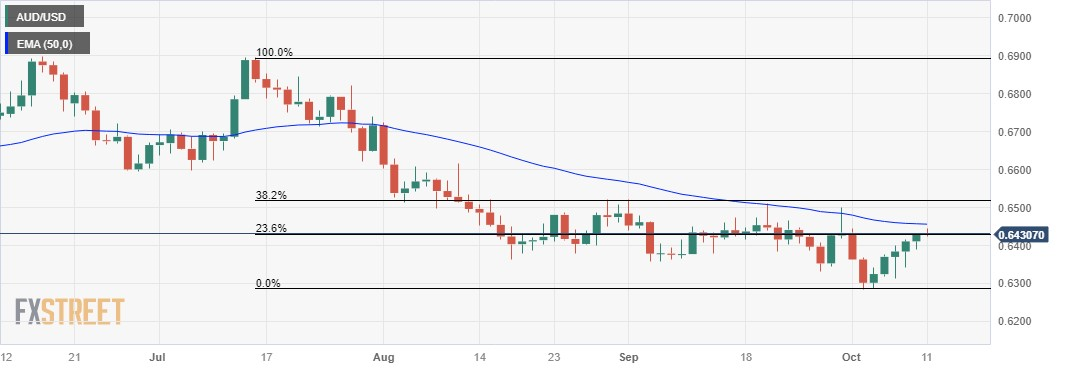- Australian Dollar pulls back from weekly highs ahead of the US Core PPI.
- Australia’s RBA is expected to increase interest rates; contributing support for the Aussie Dollar.
- The slew of dovish remarks by Fed officials contribute to pressure on the US Dollar.
The Australian Dollar (AUD) halts the five-day winning streak that began last week on a downbeat US Dollar (USD). The AUD/USD pair is strengthening as the likelihood of another interest rate hike by the Reserve Bank of Australia (RBA) increases. This trend can be linked to growing inflation expectations fueled by higher oil prices.
Australia might witness robust underlying commodity prices owing to the ongoing conflict in the Middle East. Additionally, Westpac Consumer Confidence data for October indicates an improvement in individual confidence during the same period.
Australia's business conditions showed resilience in September despite a deceleration in inflation. Moreover, Consumer Sentiment rebounded in October with unchanged rates, but the overall sentiment remained overshadowed by the rising cost of living.
Christopher Kent, Assistant Governor (Financial Markets) at the Reserve Bank of Australia (RBA), addressed the Bloomberg gathering in Sydney on Wednesday. Kent highlighted the chance to observe the economy's response to previous interest rate hikes. There are currently no intentions to accelerate the rate of bond holdings. In the event of bond sales, the approach would be careful to avoid market disturbances.
Kent also noted instances of rapid wage growth in specific sectors, although the overall impact remains contained. While acknowledging the significance of Consumer Price Index (CPI) data, Kent emphasized that it is not the sole factor influencing policy considerations.
The US Dollar Index (DXY) struggles to halt the losing streak that began last week. The US Dollar (USD) faced challenges due to the downbeat US Treasury yields on Wednesday.
Furthermore, a series of dovish-leaning comments from Fed policymakers have resonated in the markets, with many expressing worries that elevated long-term US bond yields might hinder their inclination to raise rates in the upcoming meetings.
Daily Digest Market Movers: Australian Dollar snaps the wining streak ahead of US data releases
- Australia experienced a rebound in inflation in August, primarily attributed to higher oil prices. This development increases the likelihood of another interest rate hike by the Reserve Bank of Australia (RBA).
- The escalation of the Middle East conflict could prompt the RBA to implement a 25 basis points (bps) interest rate hike, bringing it to 4.35% by the end of the year.
- The heightened geopolitical tension is contributing to increased demand for commodities like energy and gold, positively influencing the performance of the AUD/USD pair.
- Australia’s Westpac Consumer Confidence showed that current buying conditions improved in October. The index rose 2.9% from the previous 1.5% decline in September.
- After engaging in discussions with US Senators on Tuesday, China's Commerce Minister, Wang Wentao, expressed that "both sides had rational and pragmatic discussions." Emphasizing the significance of the US-China economic and trade relationship.
- The US Nonfarm Payroll report for September revealed a notable increase of 336,000 jobs, surpassing the market expectation of 170,000. The revised figure for August stood at 227,000.
- US Average Hourly Earnings (MoM) remained steady at 0.2% in September, falling short of the expected 0.3%. On an annual basis, the report indicated a rise of 4.2%, below the anticipated consistent figure of 4.3%.
- The yields on US Treasury bonds declined on Wednesday, with the 10-year US Treasury bond yield marked lower at 4.54%, down by 2.08% at the time of writing.
- Atlanta's Fed President Raphael Bostic went on record stating that the current monetary policy is already restrictive, rendering additional rate hikes unnecessary, following the dovish trajectory established by two fellow Fed colleagues on Monday, Minneapolis Fed President Neel Kashkari echoed a similar sentiment on Tuesday.
- Investors will closely watch economic data, particularly focusing on inflation figures. The Producer Price Index (PPI) is scheduled for Wednesday, followed by the release of the FOMC meeting minutes and the Consumer Price Index (CPI) on Thursday along with Australia’s Consumer Inflation Expectations.
Technical Analysis: Australian Dollar pulls back, 23.6% Fibonacci retracement acts as a barrier
The Australian Dollar hovers below the 23.6% Fibonacci retracement level at 0.6429 at the time of writing on Wednesday, presenting a noteworthy barrier. A decisive breakthrough above this level could open the door for further upward exploration, targeting the psychological level of 0.6450. Beyond that, the 50-day Exponential Moving Average (EMA) at 0.6456 emerges as a potential resistance, following the 38.2% Fibonacci retracement at 0.6518. On the downside, a pivotal support level is identified at 0.6400, following the monthly low at 0.6342. These levels play a crucial role in indicating potential shifts in the trajectory of the AUD/USD pair.
AUD/USD: Daily Chart
Australian Dollar price today
The table below shows the percentage change of Australian Dollar (AUD) against listed major currencies today. Australian Dollar was the weakest against the Swiss Franc.
| USD | EUR | GBP | CAD | AUD | JPY | NZD | CHF | |
| USD | -0.03% | 0.09% | 0.10% | 0.14% | 0.04% | 0.30% | -0.21% | |
| EUR | 0.03% | 0.12% | 0.12% | 0.19% | 0.07% | 0.32% | -0.19% | |
| GBP | -0.08% | -0.12% | 0.01% | 0.06% | -0.04% | 0.24% | -0.29% | |
| CAD | -0.10% | -0.12% | -0.01% | 0.04% | -0.05% | 0.20% | -0.31% | |
| AUD | -0.14% | -0.16% | -0.05% | -0.04% | -0.09% | 0.15% | -0.37% | |
| JPY | -0.03% | -0.06% | 0.05% | 0.06% | 0.09% | 0.28% | -0.25% | |
| NZD | -0.30% | -0.33% | -0.23% | -0.21% | -0.15% | -0.27% | -0.53% | |
| CHF | 0.20% | 0.18% | 0.27% | 0.30% | 0.34% | 0.25% | 0.50% |
The heat map shows percentage changes of major currencies against each other. The base currency is picked from the left column, while the quote currency is picked from the top row. For example, if you pick the Euro from the left column and move along the horizontal line to the Japanese Yen, the percentage change displayed in the box will represent EUR (base)/JPY (quote).
Economic Indicator
United States Producer Price Index ex Food & Energy (YoY)
The Producer Price Index ex Food & energy released by the Bureau of Labor statistics, Department of Labor measures the average changes in prices in primary markets of the US by producers of commodities in all states of processing. Those volatile products such as food and energy are excluded in order to capture an accurate calculation. Generally speaking, a high reading is seen as positive (or bullish) for the USD, whereas a low reading is seen as negative (or bearish).
Read more.Economic Indicator
United States FOMC Minutes
FOMC stands for The Federal Open Market Committee that organizes 8 meetings in a year and reviews economic and financial conditions, determines the appropriate stance of monetary policy and assesses the risks to its long-run goals of price stability and sustainable economic growth. FOMC Minutes are released by the Board of Governors of the Federal Reserve and are a clear guide to the future US interest rate policy.
Read more.Why it matters to traders
Minutes of the Federal Open Market Committee (FOMC) is usually published three weeks after the day of the policy decision. Investors look for clues regarding the policy outlook in this publication alongside the vote split. A bullish tone is likely to provide a boost to the greenback while a dovish stance is seen as USD-negative. It needs to be noted that the market reaction to FOMC Minutes could be delayed as news outlets don’t have access to the publication before the release, unlike the FOMC’s Policy Statement.
Information on these pages contains forward-looking statements that involve risks and uncertainties. Markets and instruments profiled on this page are for informational purposes only and should not in any way come across as a recommendation to buy or sell in these assets. You should do your own thorough research before making any investment decisions. FXStreet does not in any way guarantee that this information is free from mistakes, errors, or material misstatements. It also does not guarantee that this information is of a timely nature. Investing in Open Markets involves a great deal of risk, including the loss of all or a portion of your investment, as well as emotional distress. All risks, losses and costs associated with investing, including total loss of principal, are your responsibility. The views and opinions expressed in this article are those of the authors and do not necessarily reflect the official policy or position of FXStreet nor its advertisers. The author will not be held responsible for information that is found at the end of links posted on this page.
If not otherwise explicitly mentioned in the body of the article, at the time of writing, the author has no position in any stock mentioned in this article and no business relationship with any company mentioned. The author has not received compensation for writing this article, other than from FXStreet.
FXStreet and the author do not provide personalized recommendations. The author makes no representations as to the accuracy, completeness, or suitability of this information. FXStreet and the author will not be liable for any errors, omissions or any losses, injuries or damages arising from this information and its display or use. Errors and omissions excepted.
The author and FXStreet are not registered investment advisors and nothing in this article is intended to be investment advice.
Recommended content
Editors’ Picks

AUD/USD retakes 0.6000 on the road to recovery amid US-China trade war
AUD/USD is off the five-year low but remains heavy near 0.6000 in the Asian session on Monday. The pair continues to suffer from a US-China trade war as US President Trump said that he would not do a deal with China until the US trade deficit was sorted out.

USD/JPY attempts tepid recovery above 146.00
USD/JPY kicks off the new week on a weaker note, though it manages to stage a tepid recovery above 146.00 early Monday. The global carnage, amid the mounting risk of a recession and a trade war led by Trump's sweeping tariffs, keeps the safe-haven Japanese Yen underpinned at the expense of the US Dollar.

Gold holds the bounce above $3,000 amid Asia risk-off profile
Gold price recovers ground above $3,000 in the Asian session on Monday. The global market turmoil extends and hence, Gold buyers manage to find their feet as trade war and recession risks escalate and revive the haven demand for the yellow metal after Friday's 'sell everything' mode.

Bitcoin could be the winner in the ongoing trade war after showing signs of decoupling from stocks
Bitcoin traded above $84,000 on Friday, showing strength despite the stock market experiencing significant declines. The market reaction stems from United States President Donald Trump's clash with the Federal Reserve Chairman Jerome Powell over interest rate decisions.

Strategic implications of “Liberation Day”
Liberation Day in the United States came with extremely protectionist and inward-looking tariff policy aimed at just about all U.S. trading partners. In this report, we outline some of the more strategic implications of Liberation Day and developments we will be paying close attention to going forward.

The Best brokers to trade EUR/USD
SPONSORED Discover the top brokers for trading EUR/USD in 2025. Our list features brokers with competitive spreads, fast execution, and powerful platforms. Whether you're a beginner or an expert, find the right partner to navigate the dynamic Forex market.




